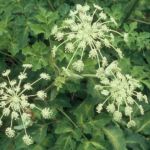| Drug Interactions: |
| Taking dong quai with these drugs may increase the risk of bleeding and bruising: |
| Abciximab, (ReoPro) |
Alteplase, (Activase, Cathflo Activase) |
Antithrombin III, (Thrombate III) |
Argatroban, (Argatroban) |
| Aspirin, (Bufferin, Ecotrin) |
Aspirin and Dipyridamole, (Aggrenox) |
Bivalirudin, (Angiomax) |
Celecoxib, (Celebrex) |
| Choline Magnesium Trysalicylate, (Trilisate) |
Clopidogrel, (Plavix) |
Dalteparin, (Fragmin) |
Danaparoid, (Orgaran) |
| Diclofenac, (Cataflam, Voltaren) |
Diflunisal, (Apo-Diflunisal, Dolobid) |
Dipyridamole, (Novo-Dipradol, Persantine) |
Drotrecogin Alfa, (Xigris) |
| Enoxaprin, (Lovenox) |
Eptifibatide, (Integrillin) |
Etodolac, (Lodine, Utradol) |
Fenoprofen, (Nalfon) |
| Flurbiprofen, (Ansaid, Ocufen) |
Fondaparinux, (Arixtra) |
Heparin, (Hepalean, Hep-Lock) |
Hydrocodone and Aspirin, (Damason-P) |
| Hydrocodone and Ibuprofen, (Vicoprofen) |
Ibritumomab, (Zevalin) |
Ibuprofen, (Advil, Motril) |
Indobufen, (Ibustrin) |
| Indomethacin, (Indocin, Novo-Methacin) |
Ketoprofen, (Orudis, Rhodis) |
Ketorolac, (Acular, Toradol) |
Lepirudin, (Refludan) |
| Meloxicam, (MOBIC, Mobicox) |
Nabumetone, (Apo-Nabumetone, Relefan) |
Nadroparin, (Fraxiparine) |
Naproxen, (Aleve, Naprosyn) |
| Oxaprozin, (Apo-Oxaprozin, Daypro) |
Piroxicam, (Feldene, Nu-Pirox) |
Reteplase, (Retavase) |
Rofecoxib, (Vioxx) |
| Salsalate, (Amgesic, Salflex) |
Streptokinase, (Streptase) |
Sulindac, (Clinoril, Nu-Sundac) |
Tenecteplase, (TNKase) |
| Tiaprofenic Acid, (Dom-Tiaprofenic, Surgam) |
Ticlopidine, (Alti-Ticlopidine, Ticlid) |
Tinzaparin, (Innohep) |
Tirofiban, (Aggrastat) |
| Tolmetin, (Tolectin) |
Urokinase, (Abbokinase) |
Valdecoxib, (Bextra) |
Warfarin, (Coumadin, Jantoven) |
| Taking dong quai with these drugs may enhance the drug's therapeutic and/or adverse effects: |
| Acebutolol, (Novo-Acebutolol, Sectral) |
Amiodarone, (Cordarone, Pacerone) |
Atenolol, (Apo-Atenol, Tenormin) |
Benazepril, (Lotensin) |
Bepridil, (Vascor) |
| Betaxolol, (Betoptic S, Kerlone) |
Bisoprolol, (Monocor, Zebeta) |
Bumetanide, (Bumex, Burinex) |
Candesartan, (Atacand) |
Captopril, (Capoten, Novo-Captopril) |
| Carteolol, (Cartrol, Occupress) |
Carvedilol, (Coreg) |
Cilazapril, (Inhibace) |
Clonidine, (Catapres, Duraclon) |
Cyproterone and Ethinyl Estradiol, (Diane-35) |
| Diltiazem, (Cardizem, Tiazac) |
Doxazosin, (Alti-Doxazosin, Cardura) |
Enalapril, (Vasotec) |
Eprosartan, (Teveten) |
Estradiol, (Climara, Estrace) |
| Estrogens (Conjugated A/Synthetic), (Cenestin) |
Estrogens (Conjugated/Equine), (Cenestin, Premarin) |
Estrogens (Esterified), (Estratab, Menest) |
Estropipate, (Ogen, Ortho-Est) |
Ethinyl Estradiol, (Estinyl) |
| Ethinyl Estradiol and Ethynodiol Diacetate, (Demulen, Zovia) |
Ethinyl Estradiol and Etonogestrel, (NuvaRing) |
Ethinyl Estradiol and Levonorgestrel, (Alesse, Triphasil) |
Ethinyl Estradiol and Norethindrone, (Brevicon, Ortho-Novum) |
Ethinyl Estradiol and Norgestimate, (Cyclen, Ortho Tri-Cyclen) |
| Ethinyl Estradiol and Norgestrel, (Cryselle, Ovral) |
Felodipine, (Plendil, Renedil) |
Fosfomycin, (Monurol) |
Furosemide, (Apo-Furosemide, Lasix) |
Hydralazine, (Apresoline, Novo-Hylazin) |
| Hydrochlorothiazide, (Apo-Hydro, Microzide) |
Indapamide, (Lozol, Nu-Indapamide) |
Irbesartan, (Avapro) |
Isradipine, (DynaCirc) |
Labetalol, (Normodyne, Trandate) |
| Lisinopril, (Prinivil, Zestril) |
Losartan, (Cozaar) |
Metolazone, (Mykrox, Zaroxolyn) |
Metoprolol, (Betaloc, Lopressor) |
Moexipril, (Univasc) |
| Nadolol, (Apo-Nadol, Corgard) |
Nicardipine, (Cardene) |
Nifedipine, (Adalat CC, Procardia) |
Nimodipine, (Nimotop) |
Nisoldipine, (Sular) |
| Norgestrel, (Ovrette) |
Oxprenolol, (Slow-Trasicor, Trasicor) |
Perindopril Erbumine, (Aceon, Coversyl) |
Pindolol, (Apo-Pindolol, Novo-Pindol) |
Prazosin, (Minipress, Nu-Prazo) |
| Propanolol, (Inderal, InnoPran XL) |
Quinapril, (Accupril) |
Ramipril, (Altace) |
Telmisartan, (Micardis) |
Terazosin, (Hytrin, Novo-Terazosin) |
| Torsemide, (Demadex) |
Trandolapril, (Mavik) |
Valsartan, (Diovan) |
Verapamil, (Calan, Isoptin SR) |
| Taking dong quai with these drugs may alter/interfere with the action of the drug, and is best avoided by those with estrogen-dependent tumors: |
| Anastrozole, (Arimidex) |
Carbocysteine, (Mucopront, Rhinatiol) |
Cisplatin, (Platinol-AQ) |
Cyclophosphamide, (Cytoxan, Neosar) |
Doxorubicin, (Adriamycin, Rubex) |
| Epirubicin, (Ellence, Pharmorubicin) |
Exemestane, (Aromasin) |
Fluorouracil, (Adrucil, Efudex) |
Megestrol, (Lin-Megestrol, Megace) |
Mitomycin, (Mutamycin) |
| Mitoxantrone, (Novantrone) |
Paclitaxel, (Onxol, Taxol) |
Tamoxifen, (Nolvadex, Tamofen) |
Thiotepa, (Thioplex) |
Vinblastine, (Velban) |
| Taking dong quai with these drugs may increase skin sensitivity to sunlight: |
| Beraxotene, (Targretin) |
Bumetanide, (Bumex, Burinex) |
Celecoxib, (Celebrex) |
Chlorpromazine, (Thorazine) |
Ciprofloxacin, (Ciloxan, Cipro) |
Dacarbazine, (DTIC, DTIC-Dome) |
| Demeclocycline, (Declomycin) |
Doxycycline, (Apo-Doxy, Vibramycin) |
Enalapril, (Vasotec) |
Etodolac, (Lodine, Utradol) |
Fluocinonole, Hydroquinone, and Tretinoin, (Tri-Luma) |
Fluphenazine, (Modecate, Prolixin) |
| Fosinopril, (Monopril) |
Furosemide, (Apo-Furosemide, Lasix) |
Gatifloxacin, (Tequin, Zymar) |
Gemifloxacin, (Factive) |
Hydrochlorothiazide, (Apo-Hydro, Microzide) |
Hydrochlorothiazide and Triamterene, (Dyazide, Maxzide) |
| Ibuprofen, (Advil, Motrin) |
Isotretinoin, (Accutane, Caravis) |
Ketoprofen, (Orudis, Rhodis) |
Ketorolac, (Acular, Toradol) |
Lanzoprazole, (Prevacid) |
Levofloxacin, (Maxaquin) |
| Loratadine, (Alavert, Claritin) |
Methotrexate, (Rheumatrix, Trexall) |
Methotrimeprazine, (Novo-Meprazine, Nozain) |
Metolazone, (Mykrox, Zaroxolyn) |
Minocycline, (Dynacin, Minocin) |
Naproxen, (Aleve, Naprosyn) |
| Nortriptyline, (Aventyl HCl, Pamelor) |
Ofloxacin, (Floxin, Ocuflox) |
Olanzapine, (Zydis, Zyprexa) |
Omeprazole, (Losec, Prilosec) |
Phenytoin, (Dilantin, Phenytek) |
Piroxicam, (Feldene, Nu-Pirox) |
| Prochlorperazine, (Compazine, Compro) |
Quinapril, (Accupril) |
Risperidone, (Risperdal) |
Rofecoxib, (Vioxx) |
Sparfloxacin, (Zagam) |
Sulfadiazine, (Microsulfon) |
| Sulfamethoxazole and Trimethoprim, (Bactrim, Septra) |
Sulfasalazine, (Alti-Sulfasalazine, Azulfidine) |
Sulfinpyrazone, (Apo-Sulfinpyrazone, Nu-Sulfinpyrazone) |
Sulfisoxazole, (Gantrisin) |
Tetracycline, (Novo-Tetra, Sumycin) |
Thioridazine, (Mellaril) |
| Trentinoin, Oral, (Vesanoid) |
Trifluoperazine, (Novo-Trifluzine, Stelazine) |
Trovaflaxacin, (Trovan) |
Zuclopenthixol, (Clopixol) |
|

